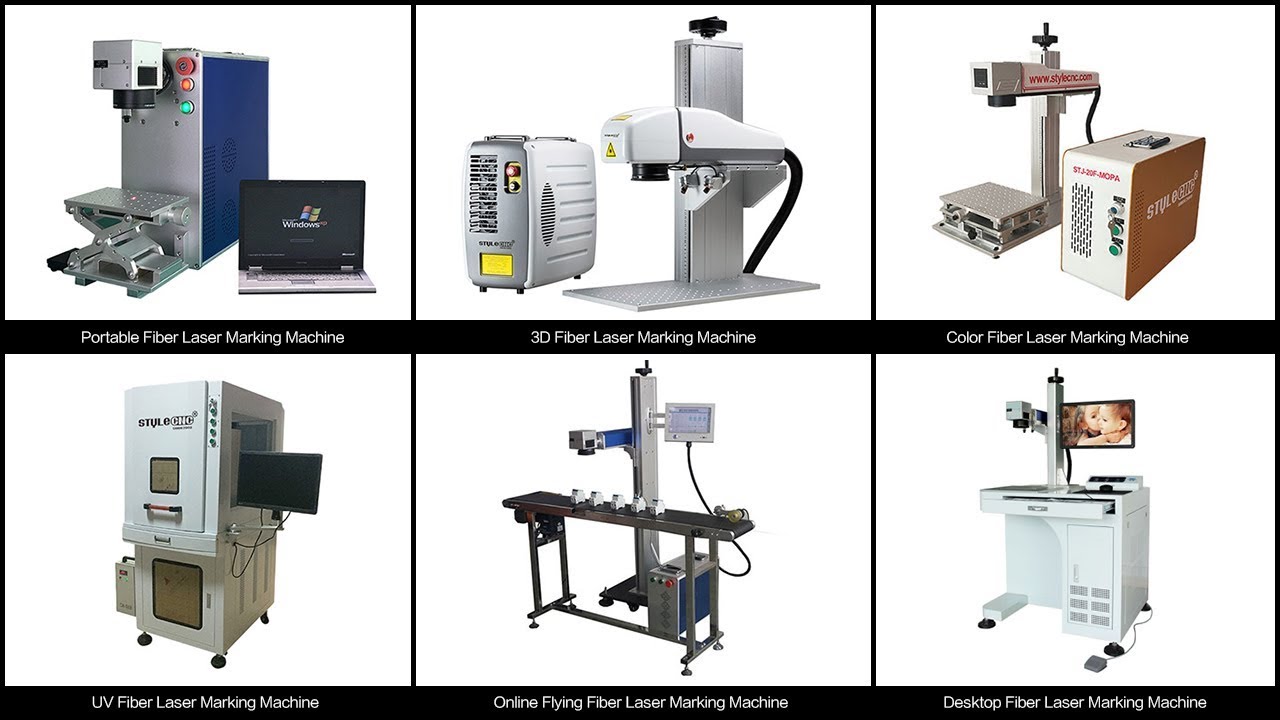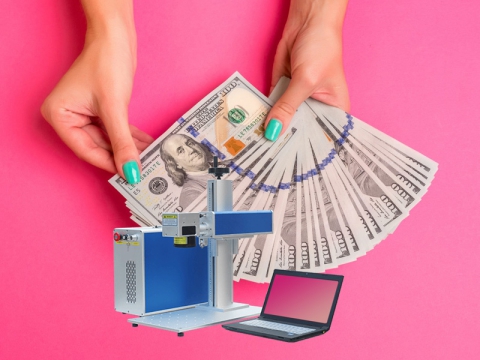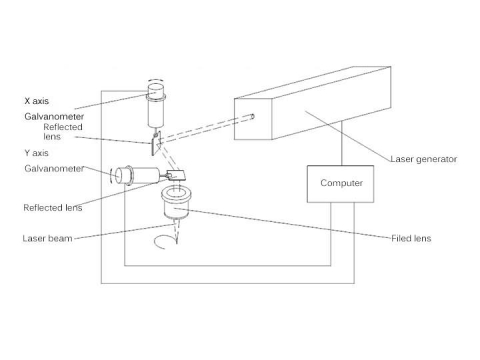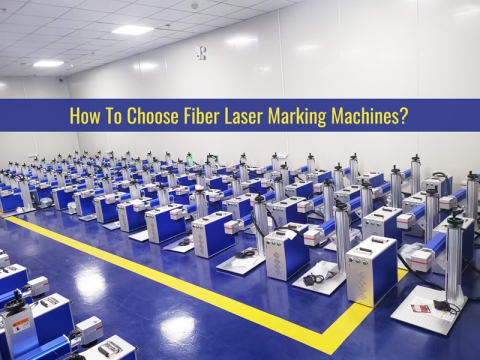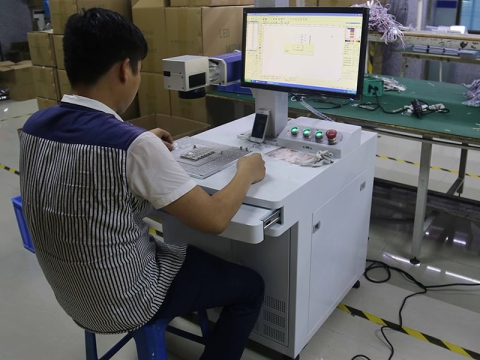What is a Laser Marking Machine?
Laser marking is a method for labeling various kinds of objects using a laser. The principle of laser marking is that a laser beam somehow modifies the optical appearance of a surface that it hits. This can occur through a variety of mechanisms:
1. Ablation of material (laser engraving); sometimes removing some colored surface layer.
2. Melting a metal, thus modifying the surface structure.
3. Slight burning (carbonization) e.g. of paper, cardboard, wood, or polymers.
4. Transformation (e.g. bleaching) of pigments (industrial laser additives) in a plastic material.
5. Expansion of a polymer, if e.g. some additive is evaporated.
6. Generation of surface structures such as small bubbles.

By scanning the laser beam (e.g. with two movable mirrors), it is possible to quickly write letters, symbols, bar codes, and other graphics, using a vector scan or a raster scan. Another method is to use a mask which is imaged on the workpiece (projection marking, mask marking). This method is simple and faster (applicable even with moving workpieces) but less flexible than scanning.
"Laser marking" stands for marking or labeling of workpieces and materials with a laser beam. In this regard, different processes are distinguished, such as engraving, removing, staining, annealing and foaming. Depending on the material and the quality requirement, each of these procedures has its own advantages and disadvantages.
How Does a Laser Marking Machine Work?
Laser technology basics
All lasers consist of three components:
1. An external pump source.
2. The active laser medium.
3. The resonator.
The pump source guides external energy to the laser.
The active laser medium is located on the inside of the laser. Depending on the design, the laser medium can consist of a gas mixture (CO2 laser), of a crystal body (YAG laser) or glass fibers (fiber laser). When energy is fed to the laser medium through the pump, it emits energy in the form of radiation.
The active laser medium is located between two mirrors, the "resonator". One of these mirrors is a one-way mirror. The radiation of the active laser medium is amplified in the resonator. At the same time, only a certain radiation can leave the resonator through the one-way mirror. This bundled radiation is the laser radiation.
Benefits of Laser Marking Machine
High-Precision Marking at Constant Quality
Thanks to the high precision of laser marking, even very delicate graphics, 1-point fonts and very small geometries will turn out clearly legible. At the same time, marking with the laser ensures constant high-quality results.
High Marking Speed
Laser marking is one of the fastest marking processes available in the market. This results in high productivity and cost benefits during manufacture. Depending on the material structure and size, different laser sources (e. g. fiber lasers) or laser machines (e. g. galvo lasers) can be used to further increase the speed.
Durable Marking
Laser etching is permanent and at the same time resistant to abrasion, heat and acids. Depending on the laser parameter settings, certain materials can also be marked without damaging the surface.
Laser Marking Machine Applications
Laser marking machine has a huge variety of applications:
1. Adding part numbers, “use by” dates and the like on food packages, bottles, etc.
2. Adding traceable information for quality control.
3. Marking printed circuit boards (PCBs), electronic components, and cables.
4. Printing logos, bar codes and other information on products.
Compared with other marking technologies such as ink jet printing and mechanical marking, laser marking has a number of advantages, such as very high processing speeds, low operation cost (no use of consumables), constant high quality and durability of the results, avoiding contaminations, the ability to write very small features, and very high flexibility in automation.
Plastic materials, wood, cardboard, paper, leather and acrylic are often marked with relatively low-power CO2 lasers. For metallic surfaces, these lasers are less suitable due to the small absorption at their long wavelengths (around 10 μm); laser wavelengths e.g. in the 1-μm region, as can be obtained e.g. with lamp- or diode-pumped Nd:YAG lasers (typically Q-switched) or with fiber lasers, are more appropriate. Typical laser powers used for marking are of the order of 10 to 100 W. Shorter wavelengths such as 532 nm, such as obtained by frequency doubling of YAG lasers, can be advantageous, but such sources are not always economically competitive. For marking of metals like gold, which has too low absorption in the 1-μm spectral region, short laser wavelengths are essential.
Metals
Stainless steel, aluminum, gold, silver, titanium, bronze, platinum or copper
The laser has been serving well for many years, particularly when it comes to laser engraving and laser marking metals. Not only soft metals, such as aluminum but steel or very hard alloys can also be marked accurately, legibly and quickly using a laser. With certain metals, such as steel alloys, it is even possible to implement corrosion-resistant markings without damaging the surface structure using annealing marking. Products made of metal are marked with lasers in a wide range of industries.
Plastics
Polycarbonate(PC), Polyamide(PA), Polyethylene (PE), Polypropylene (PP), Acrylonitrile butadiene styrene copolymer (ABS), Polyimide (PI), Polystyrene (PS), Polymethylmetacrylate (PMMA), Polyester (PES)
Plastics can be marked or engraved with lasers in a variety of ways. With a fiber laser, you can mark many different commercially used plastics, such as polycarbonate, ABS, polyamide, and many more with a permanent, quick, high-quality finish. Thanks to the low set-up times and flexibility a marking laser offers, you can mark even small batch sizes economically.
Organic materials
Organic materials require special solutions in order to provide them with permanent markings with clear contours. Our experts develop Laser Marking Systems that perfectly address this requirement. Systems whose intensity can be controlled so as to keep heat generation within the desired limits.
Glass and Ceramics
Material such as glass and ceramics place rigorous demands on our customers and the industries they operate in. For this purpose, STYLECNC has developed a technology able to apply high-contrast, crack-free markings to glass.
Different Processes of Laser Marking Machine
Annealing Marking
Annealing marking is a special type of laser etching for metals. The heat effect of the laser beam causes an oxidation process underneath the material surface, resulting in a color change on the metal surface.
During laser engraving, the workpiece surface is melted and evaporated with the laser. Consequently, the laser beam removes the material. The thus produced impression in the surface is the engraving.
Removing
During removing, the laser beam removes the top coats applied to the substrate. A contrast is produced as a result of the different colors of top coat and substrate. Common materials that are laser marked by way of removing of material include anodized aluminum, coated metals, foils and films, or laminates.
Foaming
During foaming, the laser beam melts a material. During this process, gas bubbles are produced in the material, which reflect the light diffusely. The marking will thus turn out lighter than the areas that have not been etched. This type of laser marking is used mainly for dark plastics.
Carbonizing
Carbonizing enables strong contrasts on bright surfaces. During the carbonizing process the laser heats up the surface of the material (minimum 100° C) and oxygen, hydrogen or a combination of both gases is emitted. What's left is a darkened area with higher carbon concentration.
Carbonizing can be used for polymers or bio-polymers such as wood or leather. Since carbonizing always leads to dark marks, the contrast on dark materials will be rather minimal.
Color engraving is a marking process that uses MOPA fiber laser source to mark color on metal surface such as stainless steel, titanium, etc. MOPA refers to a configuration consisting of a master laser (or seed laser) and an optical amplifier to boost the output power.
3D Marking
The 3D laser marking system is through software control optical expanded beam lens in the optical axis direction high speed reciprocating motion, dynamic adjustment of the focal length of the laser beam, making focal spot in different locations on the surface of workpiece keep uniform, so as to realize the 3D surface, a surface precision of laser processing.
